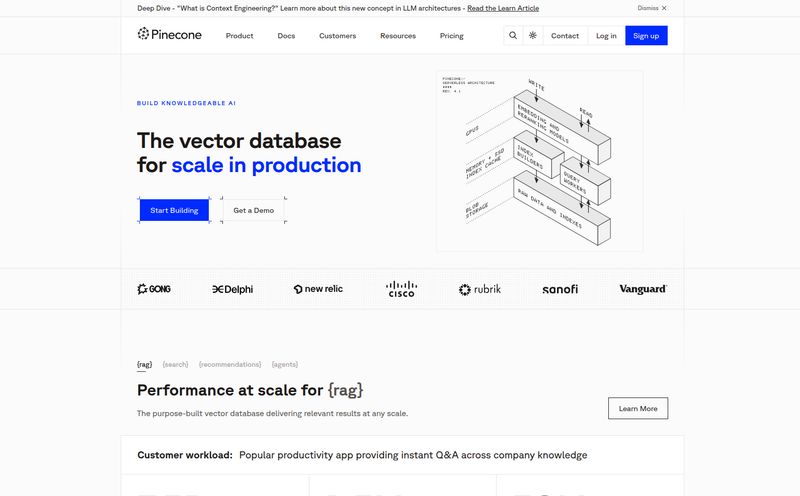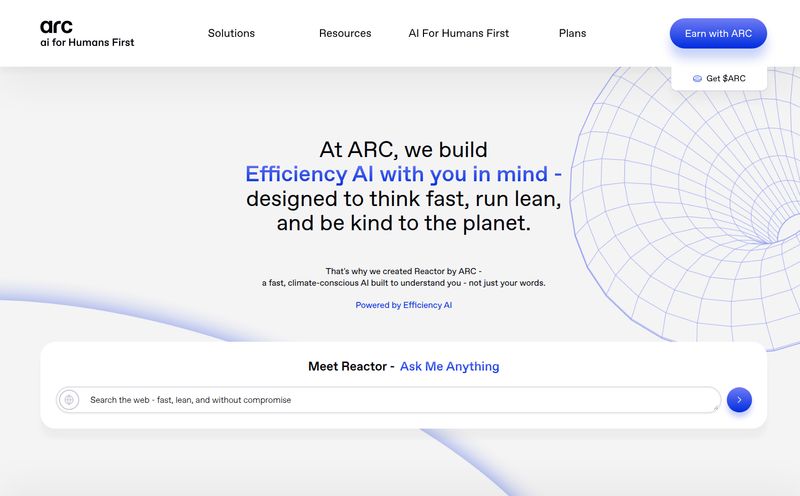The other day I was poking around the web, trying to find some concrete details on Luma AI's pro plans—you know, doing my due diligence as an SEO guy who lives and breathes this stuff. And where did I land? A beautifully designed, minimalist “Page Not Found” screen. Classic. But honestly, it was kind of perfect. It sent me down a rabbit hole, clicking through their footer links to their Discord, their API docs, and their new video tool, Dream Machine.
It perfectly captures the current state of Luma AI: a little bit mysterious, rapidly expanding, and absolutely buzzing with potential. In a world drowning in AI-generated text and images, Luma is carving out a fascinating niche. It’s not just about creating things from scratch; it’s about capturing our real world in breathtaking, three-dimensional detail. And their goal? To put the power of Hollywood-level VFX into the hands of, well, everyone. A bold claim. Let’s see if they back it up.
So, What Exactly is Luma AI?
Forget what you think you know about those clunky 3D scanning apps from a few years ago. Luma AI is a different beast entirely. At its core, it's a platform that uses some seriously advanced AI—we're talking tech along the lines of NeRFs (Neural Radiance Fields)—to create 3D models from video. You walk around an object with your phone, and Luma’s brain doesn’t just stitch photos together; it builds a genuine understanding of the object’s shape, texture, and even how light interacts with its surface. Think of it like giving your smartphone camera a Ph.D. in optical physics.
The result? You can get these stunningly lifelike 3D captures with realistic reflections and intricate details that used to require a studio full of expensive equipment and even more expensive artists. It's aimed at a whole spectrum of people, from game developers needing assets and VFX artists creating digital doubles, to architects visualizing spaces and even just curious hobbyists who want a 3D model of their favorite sneakers.
The Luma AI Toolkit: More Than Just an App
Luma isn't a one-trick pony. It’s an ecosystem of tools, which is probably why I got lost clicking through their site links. They’re attacking this 3D problem from multiple angles.
The Luma App for iOS
This is the entry point for most people. It’s an app you download on your iPhone (sorry, Android users, you’re a bit left out for now) and it’s ridiculously easy to get started. The process is almost a little dance: you point your camera at an object and slowly, smoothly circle it. The app guides you on the path, and once you’ve captured enough data, you upload it to Luma’s servers. A short while later, a fully-fledged 3D model pops up in your library. Of course, there's a catch. The quality of your final model is massively dependent on your technique and your environment. Good, consistent lighting is your best friend. A shaky hand or a poorly lit room can turn your potential masterpiece into a lumpy, digital blob. It’s not quite magic; you still have to put in a little work.
Dream Machine: Luma's Leap into Video Generation
And just when we thought we had them pegged as a 3D capture company, they drop Dream Machine. This is their shot across the bow at OpenAI’s Sora and other AI video generators. You give it a text prompt, and it creates a surprisingly high-quality, fluid video clip. It’s a huge, ambitious move that shows Luma AI isn’t just thinking about capturing reality, but creating it from imagination too. This makes them a company you really have to watch in the broader AI creative space.
Web APIs and Other Pro Tools
This is where things get serious for the professionals. Luma offers an API that lets developers integrate the 3D generation directly into their own workflows and applications. Imagine a large e-commerce site being able to automatically generate 3D models for every product in their catalog. That’s the kind of scale the API enables. They also support a bunch of useful export formats. You can grab your model as a USDZ to pop it straight into an augmented reality experience on an iPhone, or as a GLTF for web-based viewers. And for the serious 3D artists, you can pull it right into Blender to start tinkering. That flexibility is a major plus.
The Good, The Bad, and The Photorealistic
Okay, let's get down to it. No tool is perfect. Luma AI has moments that make you feel like you’re living in the year 2049, and other moments that… well, remind you that the tech is still new.
The biggest pro, without a doubt, is the sheer quality you can achieve. When you get a good capture, it’s not just good, it's jaw-dropping. It captures the subtle sheen on a leather wallet or the way light reflects off a glass bottle in a way that traditional photogrammetry often struggles with. It feels less like a scan and more like a captured memory. The accessibility is the other huge win. The barrier to entry for creating 3D content used to be measured in thousands of dollars and hundreds of hours of learning. Luma lowers that to the price of an iPhone and a bit of patience.

Visit Luma AI
On the flip side, the dependency on having a recent iPhone for the best experience is a bit of a bummer for a large chunk of the population. And as I mentioned, the quality is very much user-dependent. You can’t just wave your phone around and expect miracles. There’s a definite technique to it—a 'Luma dance' of smooth, overlapping movements. Then there's the pricing for the Pro version. The free tier is quite generous, but the moment you want higher quality or more exports, you hit a wall that says, “Contact Us.” In my experience, that phrase can be intimidating for freelancers or small studios who just want to know a price without getting into a sales call.
Luma AI vs. The Old Guard
So how is this different from old-school photogrammetry? For years, photogrammetry has been the go-to method. You take dozens, sometimes hundreds, of photos of an object from every conceivable angle and feed them into software like RealityCapture or Metashape. The software then finds common points in the photos and stitches them together into a 3D mesh.
Luma’s NeRF-based approach is fundamentally different. Instead of just stitching photos, it trains a neural network to understand the entire scene. It learns what the scene looks like from any viewpoint, even ones you didn't capture. This is how it creates such realistic surfaces and handles tricky things like transparency and reflections so much better. It's a leap from 2D pattern matching to true 3D scene reconstruction. As some experts over at The Verge have noted, this shift from photogrammetry to neural rendering is one of the most exciting developments in computer graphics right now.
Let’s Talk Money: The Luma AI Pricing Puzzle
Ah, pricing. The great mystery. As of my last check, Luma operates on a freemium model. You can get the app and create a certain number of captures per month for free, which is fantastic for trying it out. Seriously, go scan your desk plant. It's fun.
However, if you want to get into the pro features—higher detail captures, more exports, or API access—you’ll need to upgrade. And as I discovered on my little website adventure, the Luma AI Pro plan requires you to contact their sales team. This suggests they're targeting enterprise clients or studios with bespoke needs, which makes sense. But for an indie dev or a solo creator, a transparent pricing tier would be a welcome addition. For now, you have to be willing to start a conversation to unlock Luma's full power.
My Final Thoughts After Going Down the Rabbit Hole
So, is Luma AI the real deal? In my opinion, yes. Absolutely. It's not a perfect, polished, one-click solution for every single person. It has its quirks, its hardware preferences, and a slightly opaque pricing model for its best features. But the underlying technology is nothing short of revolutionary.
It represents a fundamental shift in how we can digitize our world. The fact that I can capture a 3D model with my phone that looks this good is something I would not have believed possible just a few years ago. And with the launch of Dream Machine, Luma is proving they’re not just a one-trick pony. They are an ambitious AI company that is moving at a breakneck pace. This isn't just a tool; it's a glimpse of a future where the line between the real and the digital becomes wonderfully, creatively blurred.
Frequently Asked Questions about Luma AI
- Is Luma AI free to use?
- Yes, Luma AI has a generous free tier that allows you to create a good number of 3D captures each month using their iOS app. For higher usage, API access, and professional features, you'll need to look into their Pro plan by contacting them.
- Do I need a special camera for Luma AI?
- No special camera is required, but you do need a compatible smartphone. Currently, the best experience and full feature set are available on modern iPhones (iPhone 11 or newer is generally recommended for best results).
- What's the difference between Luma AI and other 3D scanning apps?
- The main difference is the underlying technology. Many older apps use traditional photogrammetry, which stitches photos together. Luma uses a more advanced AI approach (based on NeRFs) that reconstructs the scene in 3D, allowing for much more realistic handling of lighting, reflections, and complex surfaces.
- Can I use Luma AI for professional work?
- Yes, absolutely. With export options like GLTF and USDZ, and an available API for scaling production, Luma is a powerful tool for game development, VFX, e-commerce, and other professional fields. You'll likely need the Pro plan for serious commercial use.
- What is Luma Dream Machine?
- Luma Dream Machine is a newer tool from Luma AI that generates video from text prompts. It's their entry into the AI video generation space, competing with models like OpenAI's Sora, and shows the company's broader ambitions in generative AI.
Conclusion
Luma AI is one of those technologies that genuinely gets me excited about the future. It’s not just an iterative improvement; it’s a leap. While it has some growing pains to work through, especially around accessibility for all users and pricing transparency, the power it puts in your hands is undeniable. If you have even a passing interest in 3D, AI, or just creating cool stuff, you owe it to yourself to check it out. Go download the app and scan your coffee mug. You might just get hooked.



